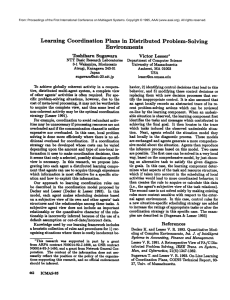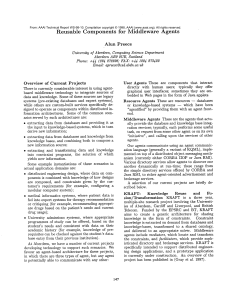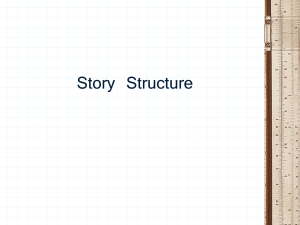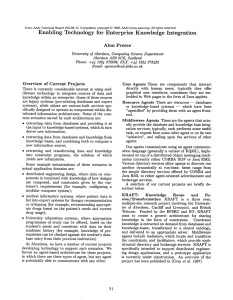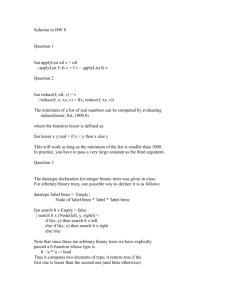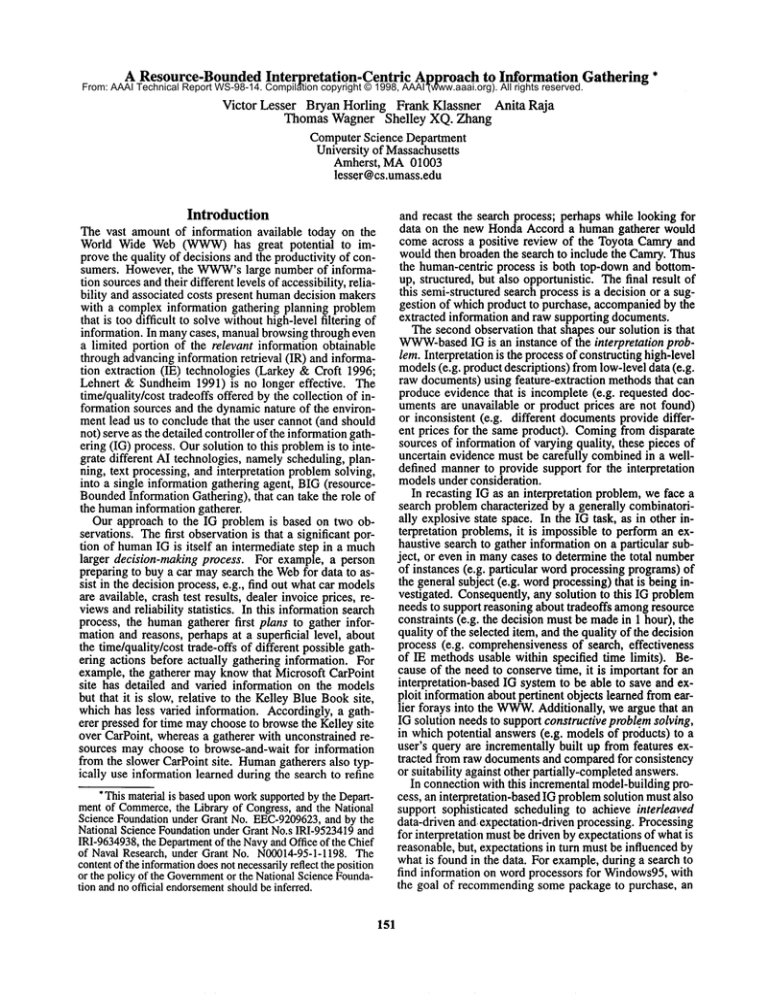
A Resource-Bounded
Interpretation-Centric
Approach to Information
Gathering
From: AAAI Technical Report WS-98-14. Compilation copyright © 1998, AAAI (www.aaai.org). All rights reserved.
*
Victor Lesser Bryan Hoding Frank Klassner
Anita Raja
Thomas Wagner Shelley XQ. Zhang
Computer Science Department
University of Massachusetts
Amherst, MA01003
lesser@cs.umass.edu
Introduction
The vast amount of information available today on the
World Wide Web (WWW)has great potential
to improve the quality of decisions and the productivity of consumers. However, the WWW’s
large number of information sourcesand their different levels of accessibility, reliability and associated costs present humandecision makers
with a complex information gathering planning problem
that is too difficult to solve without high-level filtering of
information. In manycases, manualbrowsing through even
a limited portion of the relevant information obtainable
through advancinginformation retrieval (IR) and information extraction (IE) technologies (Larkey &Croft 1996;
Lehnert & Sundheim 1991) is no longer effective. The
time/quality/cost tradeoffs offered by the collection of information sources and the dynamicnature of the environment lead us to conclude that the user cannot (and should
not) serve as the detailed controller of the informationgathering (IG) process. Our solution to this problemis to integrate different AI technologies, namelyscheduling, planning, text processing, and interpretation problemsolving,
into a single information gathering agent, BIG(resourceBoundedInformation Gathering), that can take the role of
the humaninformation gatherer.
Our approach to the IG problem is based on two observations. Thefirst observation is that a significant portion of humanIG is itself an intermediate step in a much
larger decision-making process. For example, a person
preparing to buy a car maysearch the Webfor data to assist in the decision process, e.g., find out what car models
are available, crash test results, dealer invoice prices, reviews and reliability statistics. In this informationsearch
process, the humangatherer first plans to gather information and reasons, perhaps at a superficial level, about
the time/quality/cost trade-offs of different possible gathering actions before actually gathering information. For
example, the gatherer may knowthat Microsoft CarPoint
site has detailed and varied information on the models
but that it is slow, relative to the Kelley Blue Booksite,
which has less varied information. Accordingly, a gatherer pressed for time maychoose to browsethe Kelley site
over CarPoint, whereas a gatherer with unconstrained resources may choose to browse-and-wait for information
from the slower CarPoint site. Humangatherers also typically use information learned during the search to refine
* This materialis baseduponworksupportedby the Departmentof Commerce,
the Library of Congress,and the National
Science Foundationunder Grant No. EEC-9209623,
and by the
National ScienceFoundationunder Grant No.s IRI-9523419and
IRI-9634938,
the Department
of the Navyand Office of the Chief
of Naval Research, under Grant No. N00014-95-1-1198.The
contentof the information
doesnot necessarilyreflect the position
or the policy of the Government
or the NationalScienceFoundation andno official endorsement
shouldbe inferred.
151
and recast the search process; perhaps while looking for
data on the new Honda Accord a human gatherer would
come across a positive review of the Toyota Camryand
would then broaden the search to include the Camry.Thus
the human-centric process is both top-down and bottomup, structured, but also opportunistic. The final result of
this semi-structured search process is a decision or a suggestion of which product to purchase, accompaniedby the
extracted information and raw supporting documents.
The second observation that shapes our solution is that
WWW-based
IG is an instance of the interpretation problem. Interpretation is the process of constructing high-level
models(e.g. product descriptions) fromlow-level data (e.g.
raw documents)using feature-extraction methodsthat can
produce evidence that is incomplete (e.g. requested documents are unavailable or product prices are not found)
or inconsistent (e.g. different documentsprovide different prices for the same product). Comingfrom disparate
sources of information of varying quality, these pieces of
uncertain evidence must be carefully combinedin a welldefined mannerto provide support for the interpretation
modelsunder consideration.
In recasting IG as an interpretation problem, we face a
search problem characterized by a generally combinatorially explosive state space. In the IG task, as in other interpretation problems, it is impossible to perform an exhaustive search to gather information on a particular subject, or even in manycases to determine the total number
of instances (e.g. particular word processing programs)
the general subject (e.g. wordprocessing) that is being investigated. Consequently, any solution to this IG problem
needs to support reasoning about tradeoffs amongresource
constraints (e.g. the decision must be madein 1 hour), the
quality of the selected item, and the quality of the decision
process (e.g. comprehensivenessof search, effectiveness
of IE methodsusable within specified time limits). Because of the need to conserve time, it is important for an
interpretation-based IG system to be able to save and exploit information about pertinent objects learned from earlier forays into the WWW.
Additionally, we argue that an
IG solution needs to support constructive problemsolving,
in which potential answers (e.g. modelsof products) to
user’s query are incrementally built up from features extracted from raw documentsand comparedfor consistency
or suitability against other partially-completedanswers.
In connection with this incremental model-buildingprocess, an interpretation-based IG problemsolution must also
support sophisticated scheduling to achieve interleaved
data-driven and expectation-driven processing. Processing
for interpretation must be driven by expectations of what is
reasonable, but, expectations in turn must be influenced by
what is found in the data. For example,during a search to
find information on word processors for Windows95,with
the goal of recommendingsome package to purchase, an
agent finding Excel in a review article that also contains
Word5.0 might conclude based on IE-derived expectations
that Excel is a competitor wordprocessor.
Figure 1: The BIGAgentArchitecture
The BIG Agent Architecture
The overall BIGagent architecture is shownin Figure 1.
The agent is comprised of several sophisticated components that are complex problem problem-solvers and research subjects in their own rights. The most important
componentsare:
TaskAssessorThetask assessor is responsible for formulating
an initial informationgatheringplanand then for revisingthe
plan as newinformationis learnedthat has significant ramifications for the plan currentlybeingexecuted.Thetask assessor is not the executioncomponent
nor is it the plannerthat
actually determinesthe details of howto go about achieving
informationgatheringgoals; the task assessoris a component
dedicatedto managing
the high-level viewof the information
gatheringprocess and balancingthe end-to-endtop-downapproachof the agent schedulerand the opportunisticbottom-up
RESUN
planner.
Modeling FrameworkThe T/EMS(Decker & Lesser 1993)
task modelinglanguageis usedto hierarchicallymodelthe informationgatheringprocessand enumeratealternative waysto
accomplish
the high-levelgatheringgoals. Thetask structures
probabilisticaUy
describethe quality, cost, and durationcharacteristics of eachprimitiveaction andspecifyboththe existence and degreeof any interactions betweentasks and primitive methods. The T/EMSmodelsserve as the mediumof
exchangefor the components
in BIG.
Design-to-Criteria Scheduler
Design-to-Criteria(Wagner,Garvey,&Lesser1997;1998)is
domainindependentreal-time, flexible computation(Horvitz,
Cooper, & Heckerman1989; Dean&Boddy1988) approach
to task scheduling.TheDesign-to-Criteriatask schedulerreasonsaboutquality, cost, durationanduncertaintytrade-offsof
different coursesof action andconstructs customsatisficing
schedulesfor achievingthe high-levelgoal(s).
RESUN
Planner The RESUN
(Carver & Lesser 1995) blackboardbasedplanner/problem
solver directs informationgathering activities. Theplannerreceivesan initial action schedule fromthe schedulerand then handlesinformationgathering
and processingactivities. The strength of the RESUN
planner is that it identifies,tracks, andplansto resolvesources-ofuncertainty(SOUs)associatedwith blackboardobjects, which
in this case correspondto gatheredinformationandhypothesis
aboutthe information.
Information
Extractors Theability to process retrieved documentsand extract structureddata is essential both to refine
search activities andto provideevidenceto supportBIG’sdecision making.BIGuses several informationextraction techniquesto processunstructured,semi-structured,and structured
informationrangingfroma full-blowninformationextraction
system, CRYSTAL
(Fisher et al. 1996), to pattern matchers
andtable parsers/extractors.
The integration of these componentsin BIG, and the
view of the IG problemas an interpretation task, has given
BIGsomevery strong abilities. First there is the issue of
information fusion. BIGdoes not just retrieve documents.
Instead BIGretrieves information, extracts data from the
information, and then combines the extracted data with
data extracted from other documentsto build a more complete model of the product at hand. RESUN’s
evidential
frameworkenables BIGto reason about the sources of uncertainty associated with particular aspects of product object and to even workto find corroborating or negating evidence to resolve the SOUs.BIGalso learns from previous
problemsolving episodes and reasons about resource tradeoffs to determinethe best (satisficing) course of action for
the current problemsolving context.
For moreinformation on the BIGproject, please refer to
our AAAI-98
paper (Lesser et al. 1998).
152
References
Carver, N., and Lesser, V. 1995. The DRESUN
testbed for
research in FA/Cdistributed situation assessment: Extensions to the modelof external evidence. In Proceedingsof
the First International Conferenceon Multiagent Systems.
Dean, T., and Boddy, M. 1988. An analysis of timedependent planning. In Proceedings of the Seventh National Conferenceon Artificial Intelligence, 49-54.
Decker, K. S., and Lesser, V. R. 1993. Quantitative modeling of complexenvironments. International Journal of
Intelligent Systems in Accounting, Finance, and Management 2(4):215-234.
Fisher, D.; Soderland, S.; McCarthy, J.; Feng, E; and
Lehnert, W. 1996. Description of the UMassSystems
as Used for MUC-6.In Proceedings of the 6th Message
Understanding Conference.
Horvitz, E.; Cooper, G.; and Heckerman,D. 1989. Reflection and action under scarce resources: Theoretical principles and empirical study. In Proceedingsof the Eleventh
International Joint Conferenceon Artificial Intelligence.
Larkey, L., and Croft, W. B. 1996. Combiningclassitiers in text categorization. In Proceedingsof the 19th
International Conference on Research and Development
in Information Retrieval (SIGIR ’96), 289-297.
Lehnert, W., and Sundheim, B. 1991. A performance
evaluation of text analysis technologies. AI Magazine
12(3):81-94.
Lesser, V.; Horling, B.; Klassner, E; Raja, A.; Wagner,T.;
and Zhang, S. X. 1998. BIG: A resource-bounded information gathering agent. In Proceedingsof the Fifteenth
National Conferenceon Artificial Intelligence (AAAI-98).
To appear. See also UMassCS Technical Reports 98-03
and 97-34.
Wagner, T.; Garvey, A.; and Lesser, V. 1997. Complex
Goal Criteria and Its Application in Design-to-Criteria
Scheduling. In Proceedings of the Fourteenth National
Conferenceon Artificial Intelligence, 294-301.
Wagner,T.; Garvey, A.; and Lesser, V. 1998. CriteriaDirected Heuristic Task Scheduling. International Journal of ApproximateReasoning, Special Issue on Scheduling. To appear. Also available as UMASS
CS TR-97-59.
Waterson, A., and Preece, A. 1997. Knowledgereuse
KnowledgeReuse and ValidationFollowingthe
"~:m~th~’s ~m4~er’~’:~n"th~’~" ~md ~tid~
tionof standalone
knowledge-based
systems(Preece,
Shinghal,
& Batarekh1992),toolsare underdevelopmentto assistin thedesignandvalidation
of distributedknowledge-based
systems.DISCOVERand
COVERAGEare toolsthat supportthe construction
of multiple-agent
systems.DISCOVERverifiesthat
"agentified" knowledge bases and databases conform
to a shared ontology; this is a pre-requisite for sharing knowledge in an integrated
system. DISCOVER
is described in (Waterson & Preece 1997). COVERAGEverifies the well-formedness of "teams" of agents:
it establishes the closure of task interdependencies, by
checking that agents are able to meet their advertised
commitments. COVERAGE
is described in (Lamb
Preece 1996).
Reusable Middleware Components In parallel
with the above projects, we have been attempting to
create a library of reusable middleware components
to ease the construction of knowledge base and database integration applications. Wecurrently have sets
of Java classes for:
* agent communication using a subset of KQML,running over Java RMI or CORBAIIOP;
¯ "agentifying"
SQL databases (using JDBC) and
knowledge bases implemented in CLIPS and Prolog;
¯ monitoring and visualising the interaction of agents,
for debugging and demonstration purposes.
As we gain more understanding of building these kinds
of applications, we expect to identify design patterns
which will make it easier to reuse the above classes.
ation of Knowledge-Based Systems: Papers from the
1997 AAAI Workshop (Technical Report WS-97-01).
Menlo Park, CA: AAAIPress.
Acknowledgements The author would like to acknowledge current and recent collaborators
on the
above projects at Aberdeen: Alastair Borrowman, Suzanne Embury, Jutta Eusterbrock, Ted Francis, Peter
Gray, Kit Hui, Graham Kemp, Neff Lamb, Brian Rogers, and Andrew Waterson.
References
Gray, P.; Preece, A.; Fiddian, N.; Gray, W.; BenchCapon, T.; Shave, M.; Azarmi, N.; and Wiegand, M.
1997. KRAFT:Knowledge fusion from distributed
databases and knowledge bases. In Wagner, R., ed.,
Eighth International Workshop on Database and Expert System Applications (DEXA-97), 682-691. IEEE
Press.
Lamb,N., and Preece, A. 1996. Verification of multiagent knowledge-based systems. In ECAI’96 Workshop on Validation, Verification and Refinement of
Knowledge-Based Systems, 114-119: Budapest, Hungary: ECCAI/NJSZT.
Preece, A. D.; Shinghal, R.; and Batarekh, A. 1992.
Principles and practice in verifying rule-based systems. Knowledge Engineering Review 7(2):115-141.
154

